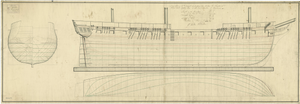 Plan of the Scamander-class frigates
| |
| History | |
|---|---|
| Name | Hebrus |
| Namesake | River Hebrus |
| Ordered | 16 November 1812 |
| Laid down | January 1813 |
| Launched | 13 September 1813 |
| Completed | 18 December 1813 |
| Commissioned | October 1813 |
| Out of service | 2 November 1816 |
| Fate | Sold 3 April 1817 |
| General characteristics [1] | |
| Class and type | Fifth-rate Scamander-class frigate |
| Tons burthen | 939 (bm) |
| Length |
|
| Beam | 38 ft 4+1⁄2 in (11.7 m) |
| Draught |
|
| Depth of hold | 11 ft 11+3⁄4 in (3.7 m) |
| Propulsion | Sails |
| Complement | 284 |
| Armament |
|
HMS Hebrus was a 36-gun Scamander-class frigate of the Royal Navy. Constructed in response to the start of the War of 1812, Hebrus was commissioned in October 1813 under Captain Edmund Palmer. Serving initially in the English Channel, on 27 March 1814 the frigate fought at the Battle of Jobourg during which she captured the French 40-gun frigate Étoile in a single-ship action. Hebrus was subsequently transferred to serve in North America. She participated in the expedition up the Patuxent River in August which resulted in the destruction of the Chesapeake Bay Flotilla, and Palmer was also present at the Battle of Bladensburg.
Hebrus fought at the Battle of Baltimore in September as part of the squadron bombarding Fort McHenry and subsequently served off the coast of Georgia in the command of Rear-Admiral George Cockburn, being present at the capture of Cumberland Island and Battle of Fort Peter in January 1815. Hebrus returned to Britain in May carrying the body of Captain Sir Peter Parker for burial in London. In the Hundred Days campaign she was then employed off Bordeaux working to support French Royalists.
In the peace after the Napoleonic Wars Hebrus was part of the Cork Station before in July 1816 she joined Admiral Lord Exmouth's fleet that in August bombarded Algiers. After this the ship was surveyed and found to be extremely rotten. Hebrus was paid off in November and eventually sold in April 1817.
- ^ Winfield (2008), pp. 435, 437.
